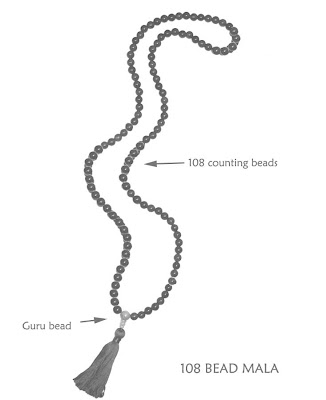what is japa mala and why does it have 108 beads?
***************
A japa mala or "mala" (means garland in Sanskrit) is a set of beads commonly used by Hindus and Buddhists, usually made from 108 beads. Malas are used to keeping count while reciting, chanting, or mentally repeating a mantra or the name or names of a deity. This practice is known in Sanskrit as japa. Malas are typically made with 19, 21, 27, 54 or 108 beads. These mantras can be recited for different purposes linked to the mind.
What malas are made of...
Material can vary according to the purpose of the mantras used. Some beads can be used for all purposes and all kinds of mantras. These beads are made of Bodhi Root, Bodhi seed or wood.
Appeasing mantras should be recited using white-colored Malas. Materials such as crystal or pearl are preferable. They can serve to purify mind and clear away obstacles like illness. This mala has 100 beads.
Increasing mantras should be recited using Malas of gold, silver or lotus seeds and with 108 beads. The mantras counted on these can serve to increase life span, knowledge or merit.
Mantras for overcoming should be recited using malas made of saffron, sandal wood or other forms of wood including elm, peach and rose wood.
Mantras to tame by forceful means should be recited using malas made of Rudraksha beads or bone. There are 25 beads on this mala, used to tame others. To tame by forceful means, means to subdue harmful energies, such as extremely malicious spirits, or general afflictions.
Using Malas...
A mantra is a word or series of words that are chanted aloud of silently to invoke spiritual qualities. Chanting is used as a spiritual tool in virtually every cultural and religious tradition. In the yogic tradition a mantra is a Sanskrit word that has special powers to transform consciousness, promote healing or fullfill desires. Mantras are typically repeated hundreds or even thousands of times. The practice of chanting a mantra is used as a form of meditation. Sitting in a comfortable position, with the eyes closed, the mantra is repeated over and over. The mind is focused on the mantra, the thoughts are let go of and the breath is slow and deep. The mala is used so that one can focus on the meaning or sound of the mantra rather than counting its repetitions.
One repetition is usually said for each bead while turning the thumb clockwise around each bead, though some traditions is said to do it counterclockwise. When arriving at the head, one turns the mala around and then goes back in the opposing direction. You are not meant to count the head bead, it is for the starting and ending point of counting your malas. For a mala bracelet that has 27 beads you would go back and forth along the bracelet 4 times to reach 108 mantras. You are not supposed to touch your pointer finger on the mala, but use your thumb and middle finger to roll the beads.
To empower the mala and the mantra used, JAPA (mantra meditation) should be practiced each day for 40 continuous days. When the mala becomes empowered it can be worn or lightly placed on oneself or others to transmit the energy of the mantra as well as the energetic qualities of the mala. When you use a new mantra on a mala it will replace any engery that the mala had before, so it is recommended that you use a new mala for each mantra you perform.
Why 108 beads..
There are numerous explanations why there are 108 beads. It bears special religious significance in a number of Hindu and Buddhist traditions.
In traditional Buddhist thought, people are said to have 108 afflictions or klesas. There are six senses (sight, sound, smell, taste, touch and consciousness) multiplied by three reactions (positive, negative or indifference) making 18 "feelings." Each of these feelings can be either "attached to pleasure or detached from pleasure" making 36 "passions", each of which may be manifested in the past, present or future. All the combinations of all these things makes a total or 108, which is represented by the beads.
Practitioners of Vajrayana Buddism, use the number 108 for a different purpose. After reciting 100 mantras, 8 more mandras are done to make up for any errors that were made.
Ananda Coomaraswamy (a Sri Lankin philosopher) holds that the numerology of the decical numberic system was key to the inception of 108. He says 1 is for bindu, 0 for Shunyata and 8 for ananta.
Photo taken by Riel in little India in Vancouver. Japa Malas and the bags they go into.





No comments:
Post a Comment